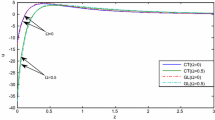Abstract
In the present paper, the three different theories (coupled theory, Lord–Shulman with one relaxation time and Green-Lindsay with two relaxation times) are applied to study the deformation of a generalized piezo-thermoelastic rotating medium under the influence of gravity and magnetic field. The normal mode analysis is used to obtain the expressions for the displacement components, the electric potential, the temperature, the stress, the strain components and the electric displacements. Comparisons are made with the results predicted by Lord–Shulman (L–S) and Green-Lindsay (G-L) theories in the presence and absence of rotation and the magnetic field as well as gravity.















Similar content being viewed by others
Abbreviations
- u i :
-
The mechanical displacement
- T:
-
The absolute temperature
- σ ij :
-
The stress tensor
- E i :
-
The electric field
- C ijkl :
-
The elastic parameters tensor
- ∊ij :
-
The dielectric moduli
- ρ :
-
The mass density
- K ij :
-
The heat conduction tensor
- C e :
-
The specific heat at constant strain
- \(\varvec{J}\) :
-
The current density vector
- \(\varvec{h}\) :
-
The induced magnetic field vector
- α 1, α 3 :
-
The coefficients of linear thermal expansion
- ɛ 0, μ 0 :
-
The electric and magnetic permeability respectively
- \(v_{p} = \sqrt {{{C_{11} } / \rho }}\) :
-
The longitudinal wave velocity in the medium
- \(\varphi\) :
-
The electric potential
- ɛ ij :
-
The strain tensor
- β ij :
-
The thermal elastic coupling tensor
- D i :
-
The electric displacement
- e ijk :
-
The piezoelectric moduli
- p i :
-
The pyroelectric moduli
- t 0, t 1 :
-
The thermal relaxation time parameters
- T 0 :
-
The reference temperature
- n 1 :
-
The non-dimensional parameter
- \(\varvec{E}\) :
-
The induced electric field vector
- H 0 :
-
The constant of magnetic field
- i :
-
The imaginary unit
References
Abd-alla AN, Alshaikh F (2017) The influence of piezoelectric and electro-magnetic effects on the propagation of Rayleigh surface waves in smart material. J Comput Theor Nanosci 13:8674–8682
Akbarzadeh AH, Babaei MH, Chen ZT (2011) Coupled thermopiezoelectric behaviour of a one dimensional functionally graded piezoelectric medium based on C–T theory. J Mech Eng Sci 225:2537–2551
Ashida F (1993) Response of a piezothermoelastic plate of crystal class 6 mm subject to axisymmetric heating. Int J Eng Sci 31:373–384
El-Naggar AM, Abd-Alla AM, Ahmed SM (1995) Influence of gravity and initial stress on the propagation of waves in an orthotropic elastic medium. Rev Roum Sci Tech Mec Appl 40:403–408
Grover D, Sharma JN (2011) Transverse vibrations in piezothermoelastic beam resonators. J Intell Mat Syst Struct 23:77–84
Hou PF, Luo ZW, Leung AYT (2010) 2D Green’s functions for two-phase orthotropic piezothermoelastic plane. J Intell Mat Sys Struct 21:557–565
Marin M (2008) Weak solutions in elasticity of dipolar porous materials. Math Probl Eng 2008:1–8. Art. No. 158908
Marin M (2016) An approach of a heat-flux dependent theory for micropolar porous media. Meccanica 51:1127–1133
Marin M, Baleanu D (2016) On vibrations in thermoelasticity without energy dissipation for micropolar bodies. Bound Value Prob 2016:1–19
Marin M, Agarwal RP, Mahmoud SR (2013) Modeling a microstretch thermoelastic body with two temperatures. Abstr Appl Anal 2013:1–7. Article ID 583464
Mindlin RD (1974) Equations of high frequency vibrations of thermopiezoelectric crystal plates. Int J Solids Struct 10:625–637
Niraula OP, Noda N (2002) Thermal stresses analysis of piezothermoelastic strip with an edge crack. J Thermal Stress 25:389–405
Othman MIA, Ahmed EAA (2015) The effect of rotation on piezothermoelastic medium using different theories. Struct Eng Mech 56:649–665
Othman MIA, Ahmed EAA (2016) The effect of gravity field on piezo-thermoelastic medium with three theories. J Thermal Stress 39:474–486
Othman MIA, Kumar R (2009) Reflection of magneto-thermoelasticity waves with temperature dependent properties in generalized thermoelasticity. Int Commun Heat Mass Transf 36:513–520
Othman MIA, Said SM (2012) The effect of rotation on two-dimensional problem of a fiber-reinforced thermoelastic with one relaxation time. Int J Thermophys 33:160–171
Othman MIA, Elmaklizi YD, Said SM (2013) Generalized thermoelastic medium with temperature-dependent properties for different theories under the effect of gravity field. Int J Thermophys 34:512–537
Othman MIA, Elmaklizi YD, Ahmed EAA (2017a) Influence of magnetic field on generalized piezo-thermoelastic rotating medium with two relaxation times. Microsyst Technol 23:5599–5612
Othman MIA, Elmaklizi YD, Ahmed EAA (2017b) Effect of magnetic field on piezothermo-elastic medium with three theories. Results Phys 7:3361–3368
Schoenberg M, Censor D (1973) Elastic waves in rotating media. Q Appl Maths 31:115–125
Sharma MD (2010) Propagation of inhomogeneous waves in anisotropic piezo-thermo-elastic media. Acta Mech 215:307–318
Sharma JN, Kumar M (2000) Plane harmonic waves in piezo-thermoelastic materials. Indian J Eng Mater Sci 7:434–442
Sharma JN, Walia V, Gupta SK (2008) Reflection of piezothermoelastic waves from the charge and stress free boundary of a transversely isotropic half space. Int J Eng Sci 46:131–146
Tianhu H, Xiaogeneg T, Yapeng S (2002) Two-dimensional generalized thermal shock a thick piezoelectric plate of infinite extent. Int J Eng Sci 40:2249–2264
Vel SS, Batra RC (2003) Generalized plane strain thermopiezoelectric analysis of multi-layered plates. J Thermal Stress 26:353–377
Walia V, Sharma JN, Sharma PK (2009) Propagation characteristics of thermoelastic waves in piezoelectric (6 mm class) rotating plate. Eur J Mech A Solids 28:569–581
Author information
Authors and Affiliations
Corresponding author
Additional information
Publisher's Note
Springer Nature remains neutral with regard to jurisdictional claims in published maps and institutional affiliations.
Appendices
Appendix A
From the MATLAB program we can validate the above expressions (55)–(57).
Appendix B
Rights and permissions
About this article
Cite this article
Othman, M.I.A., Ahmed, E.A.A. Exact analytical solution of a homogeneous anisotropic piezo-thermoelasic half-space of a hexagonal type under different fields with three theories. Microsyst Technol 25, 1423–1435 (2019). https://doi.org/10.1007/s00542-018-4089-6
Received:
Accepted:
Published:
Issue Date:
DOI: https://doi.org/10.1007/s00542-018-4089-6




